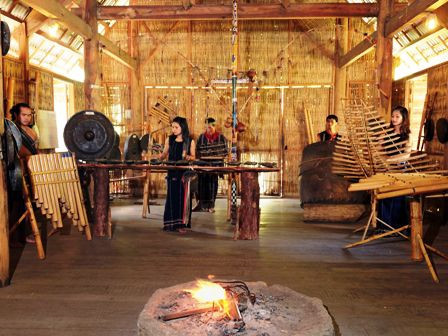
K'Ho is the oldest ethnic group in the southern central highlands. Previously, they lived mainly in high mountains and their lives were quite isolated.
K’Ho is the oldest ethnic group in the southern central highlands. Previously, they lived mainly in high mountains and their lives were quite isolated.
 |
This might be one of the reasons for many of their traditions and customs being remained until today.
K’ho, also known as Co Ho or Ko Ho, is an ethnic minority group that practices a nomadic life.
As a result, many subgroups of K’ho were established including K’ho Sre, K’ho T’ring, K’ho Tu Nop, K’ho Chil, K’ho Lach, and K’ho Don. Their language belongs to the Southern Asian linguistic system, Mon-Khmer group.
Recently, the K’ho has developed its Latin script. There are approximately 170,000 K’ho people in Vietnam scattering in Lam Dong, Binh Thuan, Khanh Hoa, Ninh Thuan, and Dong Nai province, and HCM City.
The K’ho live mainly on cultivation, animal production, and handicrafts like forging and weaving.
Like other ethnic minority groups in the Central Highlands, the K’ho still retain many of its ancient customs including religious practices.
Nguyen Van Doanh is a folk culture researcher. He said, “The K’ho believe that all aspects of life are decided by the supernatural forces. The God blesses the people while disasters are caused by the evils. In addition, the K’ho worship the Sun, Moon, Mountain, River, Earth, and Rice Genies."
"Today, they still practice worshiping rituals in honor of the Genies during their major occasions including weddings, funerals, crop prayers, and disease killing ceremonies,” he added.
During their agricultural festivals, the K’ho set up a neu bamboo pole to invite the God to come and participate in their festivals. As rice cultivation is their major job, the K’ho have many rice-related festivals including the sowing, rice nurturing, and new rice welcoming festivals.
They also organize rain praying ceremony to pray for favorable weather for bumper crop.
The K’ho have a rich folklore culture with beautiful poems and music. Their musical instruments including 6-piece gong sets, Kombuat flute, Korla bamboo-tube instrument, and Sogor drums which can produce a concert or accompany songs.
The K’ho live in hamlets called Bon, whose heads are called Kuang Bon. The Kuang Bon or hamlet chiefs represent the supreme unity in the hamlet.
The Bon or hamlet of the K’ho carries characteristics of a matriarchal tribe. The K’ho live in long houses which of the same family are close to each other. They are wooden stilt houses with curved, thatched roofs.
The staircase is in front of the house door. On the two sides of the house are shelves for the altar and containers. The family’s activities take place around the fire in the house.
In the K’ho society, families are categorized into big and small ones living under the matriarchy. The K’ho still practice the custom of “Catching husband”.
Girls must meet marriage challenges of the bridegroom family. Strong men can require big wedding presents from the brides. Therefore, sometimes wedding presents become a burden for the bride family.
After the wedding, the son-in-law lives with his wife’s family. The children carry their mother’s family name and daughters are the inheritors. Some of the backward customs of the K’ho have changed.
Mr. K Brell is a cultural official. He said, “The K’ho now have more exchanges and contacts with the Kinh majority people and other ethnic groups, so their customs have changed."
"In regard to marriage, for example, the bride family still has to bring wedding presents to the bridegroom family but the size of presents depends on the bride family’s conditions. Sometimes, the bridegroom family supports the bride with wedding presents,” he noted.
Despite increasing exchanges with other ethnic groups, the K’ho still retain their traditional, customs, and cultural identity.





